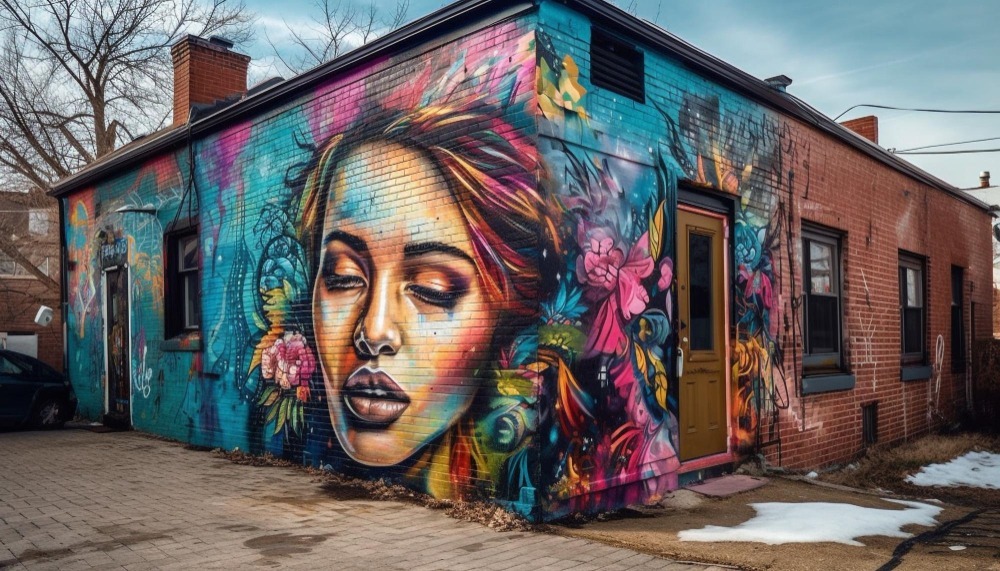Have you ever gotten lost in a city and stumbled upon a vibrant mural that stopped you in your tracks? Or perhaps you’ve scrolled through social media, captivated by a photorealistic portrait splashed across a weathered brick wall. This, my friend, is the magic of street art. It’s a vibrant art form that transforms ordinary spaces into open-air galleries, pulsating with creativity and social commentary.
But where do you even begin to delve into the local street art scene? Fear not, intrepid explorer! This comprehensive guide will equip you with everything you need to unearth the hidden gems adorning your city’s streets.
Why Street Art Matters
Street art transcends mere aesthetics. It’s a powerful medium for self-expression, social critique, and community building. Here’s a glimpse into why street art holds such significance:
- Voice for the Voiceless: Street art empowers marginalized communities to express their concerns and stories. It can be a platform for social justice movements, raising awareness about critical issues.
- Reclaiming Urban Spaces: Artists use street art to transform neglected areas into vibrant public spaces. This fosters a sense of ownership and pride within communities.
- Ephemeral Beauty: The impermanent nature of street art adds another layer of intrigue. The ever-changing canvas keeps art enthusiasts on their toes, constantly searching for the next masterpiece.
Discovering the Local Canvas
Now that you’re pumped to explore, let’s get down to the nitty-gritty of uncovering your city’s street art scene. Here are some key strategies:
- Hit the Streets: Lace up your walking shoes and embark on an exploration of your city. Pay attention to abandoned buildings, alleyways, and underpasses – these are prime spots for street art treasures.
- Embrace Technology: There are several apps and websites dedicated to street art discovery. Utilize tools like Street Art Cities or Vandalog to find curated street art maps and artist profiles in your area.
- Connect with the Community: Social media platforms like Instagram and Facebook often have dedicated groups for street art enthusiasts. Join these communities to discover hidden gems, upcoming events, and connect with local street artists.
- Follow the Artists: Many street artists have active social media profiles where they showcase their work and announce new projects. Look for local artists on Instagram and keep an eye out for their latest creations.
- Talk to the Locals: Strike up conversations with local business owners, residents, or even fellow art enthusiasts. They might have valuable insights into hidden murals or up-and-coming artists.
Beyond the Walls: Delving Deeper
Unearthing the local street art scene goes beyond simply spotting murals. Here are some ways to truly immerse yourself in this dynamic art form:
- Attend Street Art Festivals and Events: Many cities host vibrant street art festivals throughout the year. These events offer a fantastic opportunity to witness live art creation, participate in workshops, and connect with the local art community.
- Support Local Artists: If you see a piece of street art that resonates with you, consider purchasing prints or merchandise from the artist. This is a fantastic way to support their work and keep the street art scene alive.
- Volunteer for Street Art Projects: Several organizations work to promote and preserve street art. Look for volunteer opportunities with these groups to lend a helping hand and contribute to the local scene.
Respecting the Art and the Artist
Street art thrives on respect. Here are some essential guidelines to keep in mind:
- Leave No Trace: When exploring street art, be mindful of your surroundings. Don’t litter or vandalize property.
- Ask Permission Before Photographing: If a mural is located on private property, it’s courteous to seek permission from the owner before taking pictures.
- Don’t deface the Art: Street art is a form of expression, not a target for vandalism. Respect the artist’s work and leave it untouched.
- Tag Responsibly: If you’re a graffiti artist yourself, ensure you’re tagging in designated areas with permission.
The Intricate Dance Between Street Art and Gentrification: A Delicate Balance
Street art breathes life into urban landscapes, transforming neglected corners into vibrant public galleries. But as these once-marginalized areas gain popularity, a complex issue arises: gentrification. This process of urban renewal, while often bringing economic benefits, can displace established communities and threaten the very essence of street art.
A Symbiotic Relationship at Risk
In its early stages, street art flourishes in neglected areas. Artists utilize these spaces as canvases for self-expression, social commentary, and community building. Their work can spark revitalization, attracting tourists and fostering a sense of place. Coffee shops, restaurants, and art galleries may follow, injecting economic vibrancy.
However, with rising property values and increased demand for trendy spaces, the original character of the neighborhood can be lost. Rising rents force out longtime residents, often those who provided the cultural context for the street art itself. Artists who once expressed the struggles of the community may find themselves priced out, their voices silenced.
Finding Common Ground
So, how can we navigate this complex dance between street art and gentrification? Here are some potential solutions:
- Community-driven Redevelopment: Prioritize the needs of existing residents. Develop affordable housing options and integrate street art into revitalization plans, celebrating the neighborhood’s unique character.
- Artist Collaborations: Incorporate local street artists into redevelopment projects. Commission murals that reflect the neighborhood’s history and involve residents in the creative process.
- Preserving Public Art: Establish legal frameworks to protect significant street art pieces from demolition or whitewashing.
FAQs
Q: Is all graffiti considered street art?
A: Not necessarily. Graffiti encompasses any writing or drawings on a public surface, sometimes done without permission. Street art, on the other hand, is a broader term that can include murals, stencils, installations, and other artistic expressions, often created with a message or purpose. While some graffiti can be considered street art, not all graffiti falls under this category.
Q: Is it legal to take pictures of street art?
A: Generally, yes. However, if the street art is located on private property, it’s courteous to seek permission from the owner before taking photographs.
Q: How can I support local street artists?
A: There are several ways to show your appreciation! You can purchase prints or merchandise from the artist, if available. Spread the word about their work by sharing photos on social media and tagging them. Attending local street art festivals and events is another fantastic way to support the scene.
Q: What are some safety tips for exploring street art?
A: Always be aware of your surroundings, especially if venturing into unfamiliar areas. Explore during daylight hours whenever possible. If you see any suspicious activity, don’t hesitate to leave the area.
Q: I’m interested in creating street art myself. Where can I do it legally?
A: Many cities have designated areas for street art creation. Look for public walls or murals with messages encouraging participation. You can also research community art centers or programs that offer opportunities for legal street art expression.
Conclusion
The artistic tapestry woven onto our city walls is a powerful testament to the human spirit’s creativity and resilience. Street art breathes life into neglected corners, fosters community, and sparks vital conversations. However, the ever-present threat of gentrification casts a shadow, potentially silencing the very voices that gave these artistic movements life.
The path forward lies in collaboration. By prioritizing the needs of existing residents, integrating street art into thoughtful redevelopment plans, and fostering artist partnerships, we can create spaces that are both economically vibrant and culturally rich. Let’s celebrate the stories etched onto our city walls, not erase them. Let street art continue to serve as a powerful tool for social change, even as our urban landscapes evolve.
So, the next time you encounter a captivating mural, take a moment to appreciate not just the artistic skill, but the voice it represents. Explore the stories behind the art, engage with local artists, and advocate for responsible urban renewal. Remember, the future of street art lies not just in the hands of its creators, but in the hearts and minds of a community that values its transformative power.


